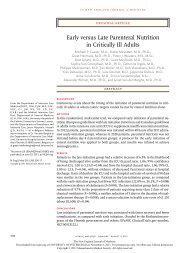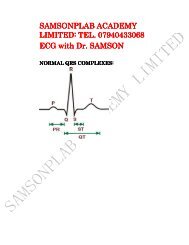ACLS Review
You also want an ePaper? Increase the reach of your titles
YUMPU automatically turns print PDFs into web optimized ePapers that Google loves.
12 <strong>ACLS</strong> (Advanced Cardiac Life Support) <strong>Review</strong> ...<br />
❍<br />
❍<br />
❍<br />
❍<br />
❍<br />
❍<br />
❍<br />
❍<br />
❍<br />
❍<br />
❍<br />
❍<br />
Why is it important not to hyperextend the head of an infant or child when ventilating?<br />
Their trachea and necks are very pliable and you may occlude the airway.<br />
What special concerns do you have in using the bag-valve-mask device on a pediatric patient?<br />
Avoid excessive bag pressure. Use only enough to make the chest rise; more than that can damage the lungs and<br />
inflate the stomach.<br />
T/F: Gastric distention is more common in adults than in children.<br />
False.<br />
If you are unable to ventilate a child using the head-tilt, jaw-thrust, or chin-lift, what should you do?<br />
Consider an oral or nasal airway.<br />
What problems do facial injuries pose to establishing and maintaining a patent airway?<br />
Because the blood supply to the face is so rich, blunt injuries to the face frequently result in severe swelling. For the<br />
same reason, bleeding into the airway from facial injuries can be a challenge to manage.<br />
T/F: Ordinary dentures should always be removed before ventilating a patient.<br />
False.<br />
What is the concern with partial dentures when ventilating a patient?<br />
They may become dislodged and occlude the airway.<br />
Identify the following: a leaf-shaped structure that prevents food and liquid from entering the trachea during<br />
swallowing.<br />
Epiglottis.<br />
Identify the following: firm cartilage ring forming at the lower portion of the larynx.<br />
Cricoid cartilage.<br />
Identify the following: two major branches of the trachea to the lungs.<br />
Bronchi.<br />
Describe the active process of inhalation.<br />
Diaphragm and intercostal muscles contract, increasing the size of the thoracic cavity. Ribs move upward and<br />
outward. Air flows into lungs.<br />
Describe the process of air exchange at the alveolar/capillary level.<br />
Oxygen-rich air enters the alveoli during each inspiration. Oxygen-poor blood in the capillaries passes into the<br />
alveoli. Oxygen enters the capillaries as carbon dioxide enters the alveoli.







